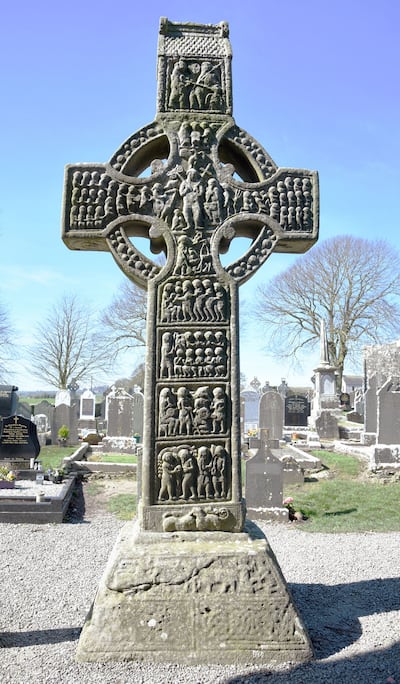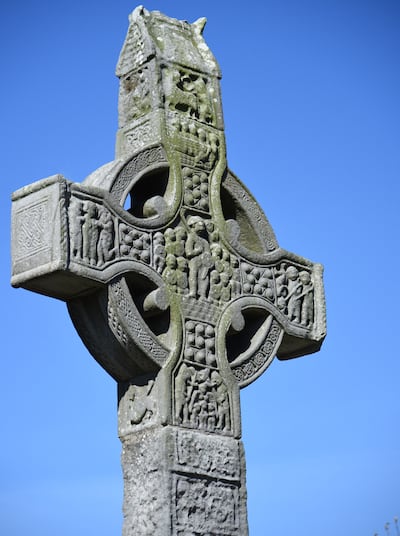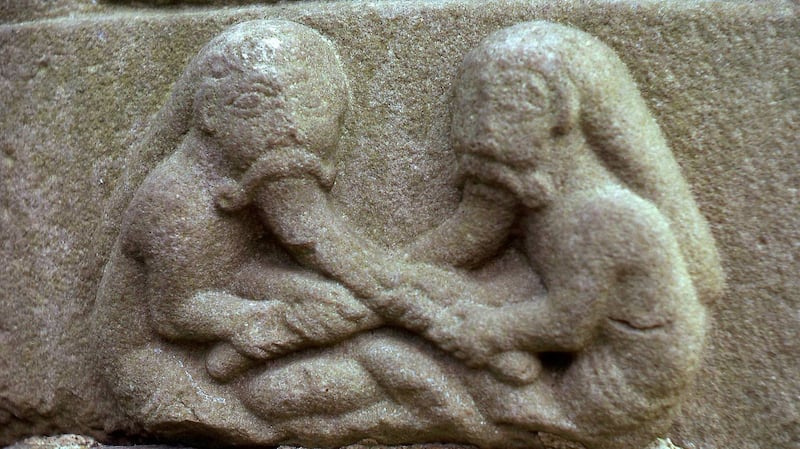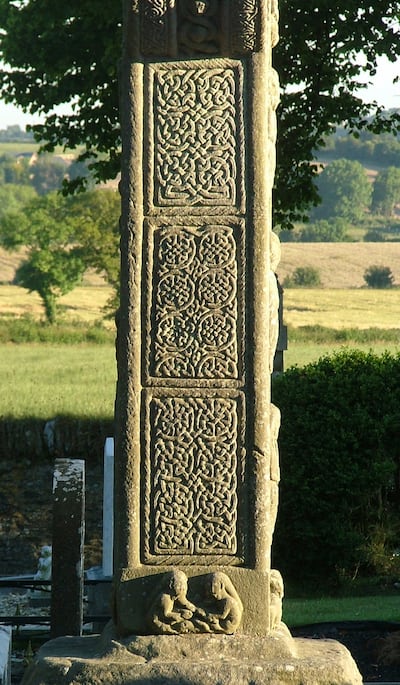The high crosses of Ireland, especially those adorned with figure sculpture, are such familiar features of our historic landscape that it is easy to take them for granted. While the meaning of the scenes depicted on the crosses have prompted intense debate, the carvings themselves have rarely been considered as works of art.
Little thought has been given to the craftsmen who made them or to the people who commissioned them. This is especially so with a group of monuments carved by the hand of a single sculptor, whose work includes the great cross at Monasterboice, erected, as an inscription explains, on the instructions of abbot Muiredach in the years before 924 AD. As so often in the middle ages, the sculptor’s name remains unknown, but it seems appropriate to describe him as the “Muiredach master”. His approach was remarkably naturalistic, the figures roundly modelled and the scenes full of attractive details – swords, drinking horns and ornate brooches. The sculptor’s style is instantly recognisable and can be identified in five or six other crosses, notably at Kells, Clonmacnoise and Durrow (Offaly). This is an impressive oeuvre. It is not often in medieval art that we can follow the work of an individual sculptor in this way.

It is sometimes assumed that medieval artists showed little interest in creativity or innovation, a view that has been widely refuted in recent years. There is plenty of ingenuity in the way that the Muiredach master handled established Christian themes, revealing a taste for humour and anecdotal detail. This comes to the fore in his carving of the Last Judgment at Monasterboice. A demon can be spotted chasing souls into hell with a three-pronged fork, while a second demon with spindly legs gives the damned a vigorous kick. Meanwhile at the foot of the cross, two men are seen pulling each other’s beards. This activity, perhaps not surprisingly, was seen as an act of derision; even so, it is hard to discern what beard-pulling contributed to the spiritual meaning of a Christian monument.
Mystery source
The making of Muiredach’s cross was a colossal undertaking. The various operations demanded a co-ordinated physical effort, not to mention foresight, planning and practical expertise. The body of the cross was cut from a huge block of quartzy sandstone which, when extracted from the quarry, must have weighed close to 10 tons. The source of this fine stone has long been a mystery but in recent years geological evidence has pointed to the hill at Carrickleck (Meath), 14 miles distant from Monasterboice.
The origin of the name, meaning “the stone bed”, reflects the ancient importance of the site. Before it was taken from the quarry, the cross was roughed out, a process that helped to reduce the weight. Key decisions about geometry and the layout of the carved panels were made at this point, indicating that the master sculptor must have been present from the start. When it came to cross-making, the quarry lay at the heart of both production and design.

One of the most contentious subjects in the history of sculpture is the question of whether carving was carried out on the ground, or delayed until the stones were already in place. Scholars of Greek sculpture are still debating this point with regard to the Parthenon in Athens, where some argue that the famous frieze was carved in situ by sculptors working on a scaffold after the temple had been built. In Ireland most of the carving must have been carried out in advance. Parts of the cross would have been quite impossible to carve otherwise.
To many people it is a surprise to learn that, in addition to axes, chisels and punches, one of the sculptor’s favoured tools was the drill. Tell-tale signs of its use are easy to spot, especially among patterns of interlace. The drill in question was almost certainly the pump drill, a type inherited from classical antiquity.
The most dramatic moment in the process of cross-making was the erection of the finished monument. This was a hazardous operation, especially in cases where the body of the cross was formed from separate pieces of stone, the two parts being fixed together by a fragile joint high above the ground. The so-called “tall cross” at Monasterboice is one of the outstanding examples. In such cases the cross-head had to be dropped vertically into place at the top of the shaft (into a mortice or socket), an exercise that involved a crane or hoist close to 30ft in height.
Man of status
The scale and engineering of the larger crosses suggest that powerful individuals were involved. This was certainly the case at Clonmacnoise, where an inscription on the “cross of scriptures” records the patronage of Flann Sinna, the high king. Likewise it is important to note that abbot Muiredach at Monasterboice was no self-effacing official, but a man of status who wielded authority throughout the region. His various titles included that of ardmaer or “steward” of the southern Uí Néill, led at that time by the same Flann Sinna.
Abbot and the king were obviously well-acquainted. The crosses at Clonmacnoise, Monasterboice and Kells are not only linked in matters of style and subject; they belong to a network of patronage, involving high-powered individuals in church and state, men who knew each other well. Once the Muiredach master had demonstrated his prowess, it is no surprise that fellow patrons wanted a cut of the action. The presence of chariots, armed warriors and hunting scenes at the base of the crosses may be significant in this regard, a hint perhaps of aristocratic involvement.

It is frequently suggested that the high crosses served as “preaching crosses”, the aim being to instruct the laity in the basic tenets of the Christian faith. This is an oft-repeated trope, one frequently illustrated with pictures of local folk gathered around the cross, receiving instruction from a preacher (presumably in benign weather). While such events may indeed have taken place, this is a somewhat innocent and romantic image of the middle ages, more in keeping with Victorian perceptions of the past.
One thing to be learned from the history of art is that utilitarian concerns were rarely the sole reason for the production of lavish monuments. When trying to justify artistic indulgence, patrons invariably fell back on didactic arguments, pointing to the value of images as a means of educating “simple folk”. One gets the impression, however, that many of the images found on the Irish crosses were aimed at a knowledgeable audience, rather than a poorly informed laity. They were certainly designed to impress as well as educate.
Monastic communities
In fact, the ringed cross was far from ideal as a framework for educational images. In the view of one expert, they look like monuments to which paintings have been attached, as if icons from inside a church had been taken down and stuck on the face of the cross. It is an interesting thought, a clue perhaps to the origin of what is a curious and unusual arrangement.

In medieval art short inscriptions were sometimes added to assist with interpretation, but no such aids were provided in Ireland. Perhaps this was felt to be unnecessary, especially if the images were already familiar, possibly in other media – wood-carvings, textiles, painted panels or manuscript illumination. One gets the impression that many scenes had their own history within monastic communities, having been copied and adapted long before they were fossilised in stone.
While the creation of the great crosses at Monasterboice, Kells and Clonmacnoise leaves us with much to ponder, their future conservation provides pressing problems. In recent years, the growth of white lichen has disfigured the appearance of some of the carving, the herbicidal sprays once employed now being considered unsafe. Inevitably there will be pressure to bring more of the crosses indoors, a process that sadly reduces their impact.
When crosses remain in the open, the visual experience varies according to the time and season, the panels lit in sparkling sequence as the rays of the sun pass from east to west. On summer evenings at Monasterboice it is hard not to experience a sense of wonder as the northern face of Muiredach’s cross is suddenly bathed in sunlight, the whole event over in just a few minutes, an experience we can still share with those who gazed at the carvings a thousand years ago.
Roger Stalley is a fellow emeritus of Trinity College Dublin, where he was formerly professor of history of art. His latest book, Early Irish Sculpture and the Art of the High Crosses (Paul Mellon Centre for Studies in British Art and Yale University Press) will be published on May 12th



















